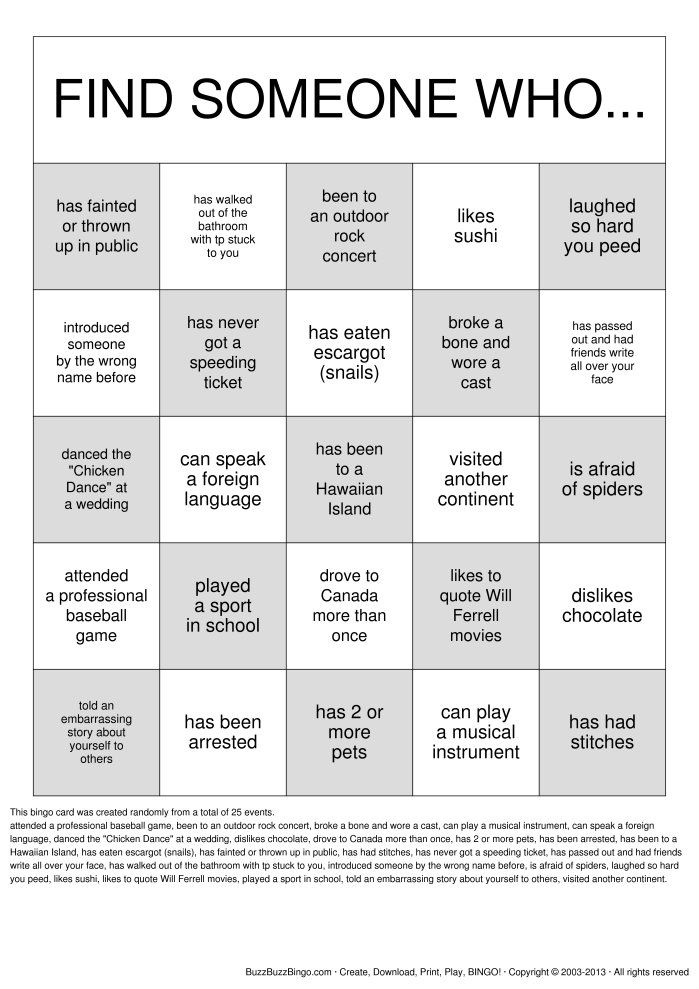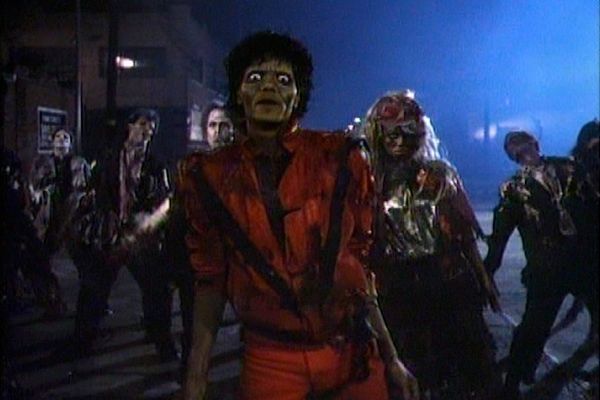How to dance english waltz
Learn Basic Steps For Waltz
Waltz is an elegant, nearly universal dance, perfect for weddings, or almost any social occasion. It's not as hard to learn as most people think.
- Basic steps
- Instructions & Diagrams
- Video
- Recommended Video Lessons »
Quick intro
Waltz dates back to the late 17th century Europe, but has never really been out of fashion and clearly stood the test of time. It should probably be one of the first ballroom dances you learn.
It is a smooth and graceful dance with long, flowing movements, characterized by rise & fall motion. It has a unique 3/4 timing and a simple rhythmic pattern which blends with the music. You can start waltzing very quickly by just learning the simple box step.
Basic steps
The basic step for waltz is a box step. It's named after a pattern it creates on the floor (box or square) and forms the foundation of the dance.
A box step can be divided into two parts - a forward half box and a backward half box. Each half box has three steps - a step forward or backward, a step to the side, and a step to close the feet together.
The leader starts with the left foot and executes a forward half box, followed by a backward half box. The follower performs the opposite – she starts with the right foot and executes a backward half box, followed by a forward half box.
The basic box step pattern uses three counts - slow, quick, quick, which is repeated twice to create the box step. Timing is 1,2,3,1,2,3 or 1,2,3,4,5,6.
Instructions & Diagrams:
When dancing waltz someone has to lead and someone has to follow. Usually the man will lead and the woman will follow.
Men's Steps:
- Step forward with the left foot
- Right foot step sideways to the right
- Bring your left foot next to your right foot
- Step back with the right foot
- Step back sideways with the left foot
- Bring your right foot next to your left foot
Lady's Steps:
- Step back with the right foot
- Left foot step sideways to the left
- Bring your right foot next to your left foot
- Step forward with the left foot
- Step forward sideways with the right foot
- Bring your left foot next to your right foot
Video
In this video Leon and Kim will show you the basic box step.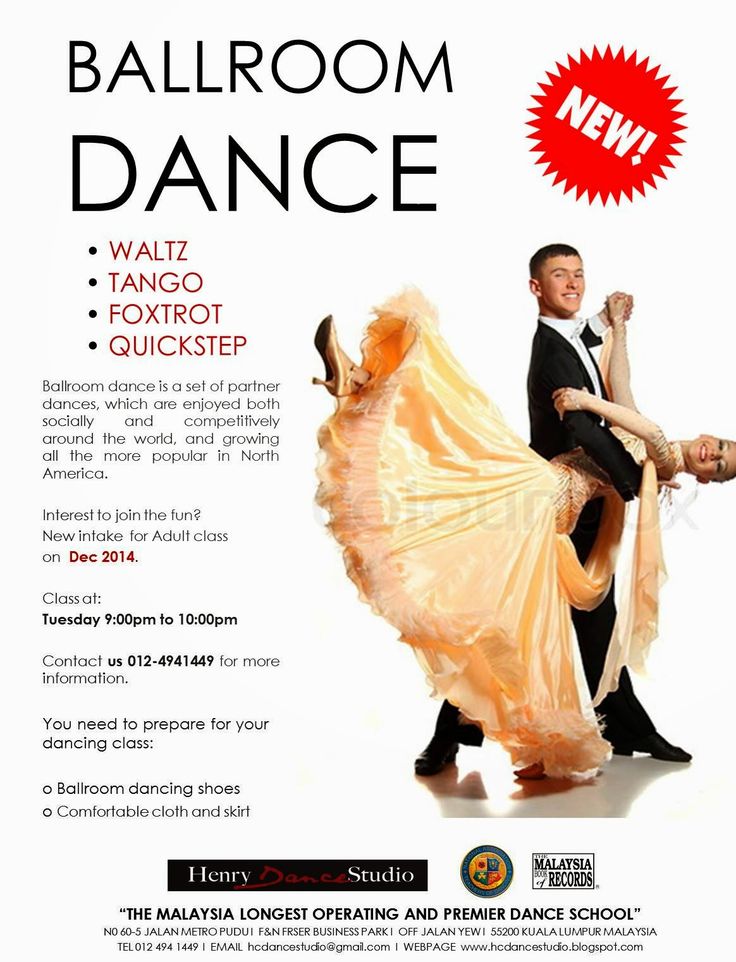 You will also get important tips on rise & fall movement which characterizes this dance:
You will also get important tips on rise & fall movement which characterizes this dance:
more videos »
Once you've mastered the basic box step, it's time to start rotating that box. It will usually be rotated to the left (counterclockwise), so it's called the Left Box Turn. It's quite simple: with each half box, you turn 1/4 of the turn to the left. After two boxes (or four half boxes) you will complete the turn and end up where you began. Then start all over again.
Ok, so now that you know the basic box and how to rotate it, lets continue with basic progressive. Here, as the name implies, the leader will always be moving forwards and the follower backwards. This will enable you to move around the dance floor instead of just dancing on the spot. Here is a clip from Learn & Master Ballroom Dance course that will show you in detail how it's done:
Where to go next?
Now that you know the basics, what's your next step (pun intended ;)? To go to the next level, we recommend one of the video training programs. Here are our recommendations »
Waltz Dance Steps
Thomas Wilson Correct Method of German and French Waltzing 1816, showing nine positions of the Waltz.Photo by unknown engraver / Public domain
How to Dance the Waltz
Waltz is a smooth dance, traveling around the line of dance. It is characterized primarily by its rise & fall action.
The shoulders move smoothly, parallel with the floor, not up and down.
The head should turn in the direction of the turn, otherwise the man's head is upright and looking over the right shoulder of the lady.
The American Waltz is similar to the International style except it has both open and closed dance positions. This allows the American style dancer a unique freedom of expression, including the ability to showcase character and theatrical presentation.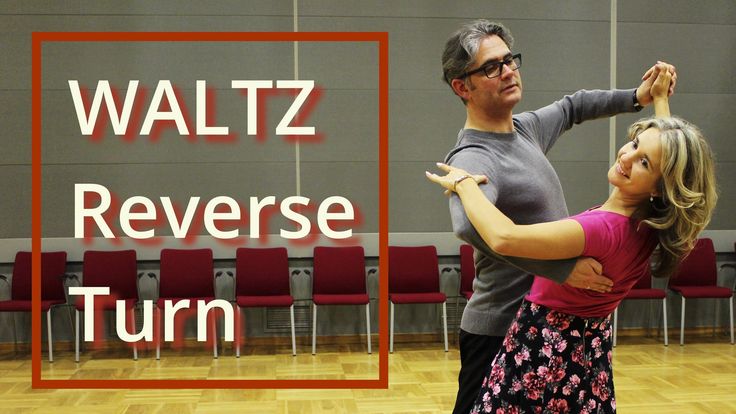
The slow waltz is danced to music written in 3/4 meter with 30 - 32 measures per minute.
Rise and Fall in Waltz
The rise and fall is unique to the waltz. If possible, all the the steps in the waltz should be long.
On the first step forward, the weight is taken on the heel, then on to the ball of the foot.
A gradual rise to the toes should be started at the end of the first beat, and continued to the second and third beat of each bar of music.
Lower to the normal position at the end of the third beat by lowering to the heel of the foot which is carrying the weight.
Waltz Left Foot Change
Man's foot position
Waltz dance step - Left foot changeStep diagram by Centralhome.com
Rhythm - One, two, three.
Waltz Right Foot Change
Man's foot position
Waltz-Steps-Right-Foot-ChangeStep diagram by Centralhome.com
Start position - facing line of dance)
Rhythm - One, two, three.
Waltz Left Box
The basic waltz steps looks like a box on the floor. The basic step is called the Left Box. It is a combination of the Left Foot Change (forward) and the Right Foot change (backwards or against the line of dance)
The basic step is called the Left Box. It is a combination of the Left Foot Change (forward) and the Right Foot change (backwards or against the line of dance)
The Box Step can also have a slight amount of turn, from 1/8 to 3/4 turn. The turn is used to turn corners or stay in a small area on a crowded nightclub dance floor.
Man's foot position
Waltz Box Step or Left Box StepStep diagram by Centralhome.com
Man starts and finished facing Line of Dance
Rhythm - One, two, three. One, two, three.
The man is in closed dance position in front of the woman, facing line of dance. The woman is slightly to the right.
Man's Steps
1. Step forward with the LF.
2. Step forward with the RF so that right foot is parallel to left foot.
3. Bring the LF to the RF.
4. Step back with the RF.
5. Step back with the LF so that the left foot is parallel to right foot.
6. Bring the RF to the LF.
Woman's Steps
1. Step back with the RF.
Step back with the RF.
2. Step back with the LF so that the left foot is parallel to right foot.
3. Bring the RF to the LF.
4. Step forward with the LF.
5. Step forward with the RF so that right foot is parallel to left foot.
6. Bring the LF to the RF.
Waltz Forward Progressive
Man's foot position(left foot change and right foot change)
Waltz step - forward progressiveStep diagram by Centralhome.com
Start position (face line of dance)
Rhythm - One, two, three.
Waltz Promenade Step
Man's foot position
Waltz step - promenadeStep diagram by Centralhome.com
Rhythm - One, two, three.
About the Author
Jake Fuller is a staff writer for Centralhome.com.
Recommended for you
More Waltz Steps - Left turn, Right turn, Whisk (man's and lady's part)
Waltz History - How old is Waltz?
Waltz Syllabus - Waltz International Standard Ballroom Dance.
International versus American Dancing - Differences in style.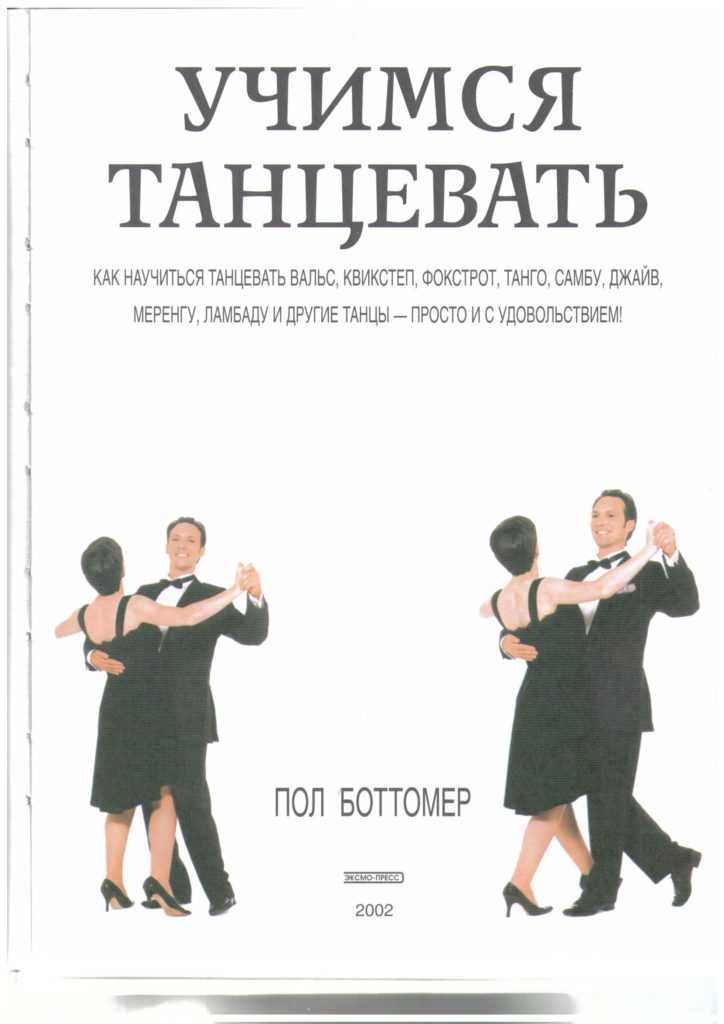
Share
Previous in Steps: Polka Steps
Next in Steps: Waltz Steps 2
Romantic English Waltz | Educational social network
Romantic English waltz
(slow waltz)
Basic information:
The simple structure of the basic figures, slow tempo, uniform basic rhythm make the English waltz one of the easiest dances to learn. Therefore, it is the first dance with which any dance training course begins.
It is said that the tempo of the modern English waltz and its romantic character must be attributed to the dislike of the phlegmatic English for fast dances. nine0003
The predecessors of the English waltz were two dances with very different characteristics: the fast, whirling Viennese waltz and the slow American Boston.
These two dances made a very interesting combination.
Victor Sylvester, an English dance teacher and head of the famous BBC dance orchestra, is considered the direct creator of the modern style of the English waltz. 1922 can be considered the date of birth of the English waltz.
1922 can be considered the date of birth of the English waltz.
The English Waltz is a slow dance of a romantic nature. This dance is mobile in space (mobile - spatial). It is danced along oblique (diagonal) lines. It is danced in pairs, in close contact, which makes it possible for a man to lead a woman with his body.
English waltz time signature ¾, tempo 30-31 beats per minute. The rhythm of the steps of the English waltz is even. Each step corresponds to a rhythmic unit.
Rhythmic durations: 1 1 1
Way of counting steps: 1 2 3 (one, two, three)
The man stands with joined feet on the RL or LP, depending on the dance figure
The right hand is placed on the left shoulder blade of the woman woman's shoulder
A woman stands with her feet together opposite a man on a MO or LN. Her body is in light contact with the man's body, or at a short distance from her partner
The woman's left hand is on the man's right shoulder
The right hand is in the partner's left hand
The partner's head is turned to the left. The view was directed in front of
The view was directed in front of
Closed change from the right leg
Description:
- The figure consists of three steps
- occupies one beat
- performed without turns
- serves to move from figures, to figures, to figures, to the figures, to the figures, to the figures, dancing with LN. nine0050
Partner's steps
PI - legs together, body weight on LN. The partner is facing in the direction of the dance.
Account
1. Step PN forward (from heel) 1
2. Step LN towards 2
3. PN attach to RL (finish with body weight on RL) 3
Lady’s steps
SP – legs together, body weight on RL. The partner is located with her back in the direction of the dance.
Account
1. Step LN back (from heel) 1
2. Step PN towards 2
3. LN to attach to PN (finish with body weight on LN) 3
Closed change from the right leg, performed on a square
(small square with PN)
Description:
- Figure consists of six steps
- Takes two cycles
- Performed without turns
Partner's steps
PI – legs together, body weight on LN.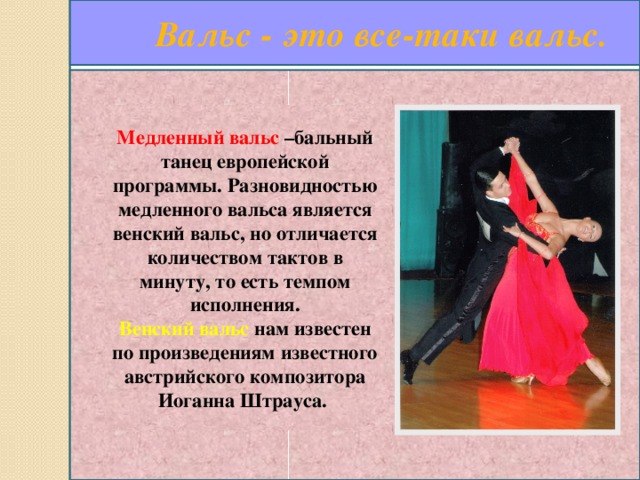 The partner is facing in the direction of the dance.
The partner is facing in the direction of the dance.
0003
1. Step of PN forward (from heel) 1
2. Step LN in the direction of 2
3. PN, attach to LN (finish body weight on Mon) 3
4. Step LN back 1
5. Step PN to the side . . . . . . . . . 2
6. LN attach to the RL (finish with the body weight on the RL) 3
Lady’s steps
PI – legs together, body weight on the RL. The partner is located with her back in the direction of the dance.
Account
1. Step LN back 1
2. Step PN in the direction of 2
3. LN put to PN (finish with body weight on LN) 3
4. Step forward 1
5. Step of PN in the direction of 2
6. PN PN to LN (finish body weight on Mon) 3
Closed change from the left foot, performed in a square
(small square with LN)
Description:
- The figure consists of six steps
- Takes two cycles
- Performed without turns
Partner’s steps The partner is facing in the direction of the dance.
Account
1. Step LN forward (from heel) 1
2. Step of PN in the direction of 2
3. LN put to PN (end with body weight on LN) 3
4. Step of Mon Back 1
5. Step LN towards 2
6. PN PN to attach to LN (finish with body weight on PN) 3
Lady's steps
PI - legs together, body weight on LN. The partner is located with her back in the direction of the dance.
Account
1. Step PN back 1
2. Step LN in the direction of 2
3. PN PN to LN (finish with body weight at Mon) 3
4. Step forward 1
5. Step PN in the direction of 2
6. LN to PN (finish body weight on LN) 3
Dance combination
(recommended combinations of figures)
The combination consists of four learned figures. Since the figures in the base are repeated, our choreography of the English Waltz consists of six figures and occupies eight bars of music.
Having completed the entire sequence of figures in the main combination, we can then repeat countless times, moving around the hall.
Remember that in the dance combination figures for men are given, and the woman, of course, dances in reverse - as was given in the description of each figure. nine0003
So:
- Closed reverse right foot (3 steps)
- Closed reverse left foot (3 steps)
- Closed reverse square right foot (6 steps)
- Closed reverse right foot (3 steps) )
- Closed reverse left square (6 steps)
- Closed reverse left foot (3 steps)
English Waltz - frwiki.wiki
For other forms of waltz, see Waltz.
A couple dancing a waltz during a dancesport competition (DanceSport). nine0003
English Waltz , also known as Slow Waltz , is a progressive ballroom dance characterized by long, flowing movements and undulating marks on the dance floor. It differs from the French and Viennese waltz by its large movements on the dance floor and slow tempo. As in other waltzes, music accompanies it in
.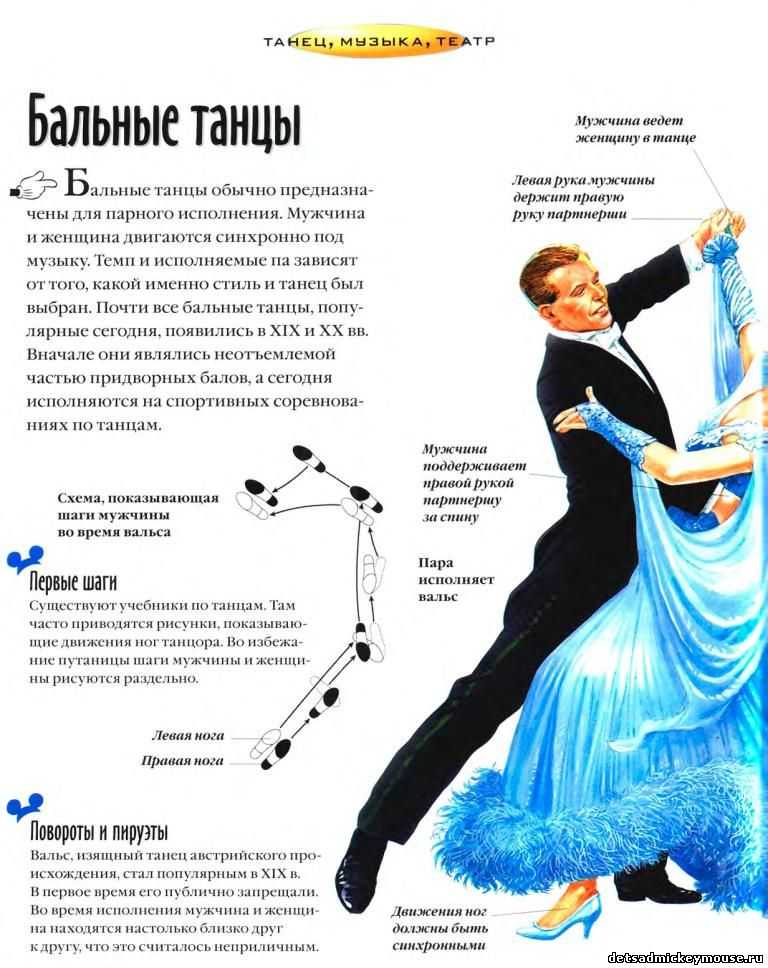 This waltz was officially distinct from the others during the 1920s, today it is danced socially or competitively mainly as one of the five standard dancesport dances (DanceSport). nine0003
This waltz was officially distinct from the others during the 1920s, today it is danced socially or competitively mainly as one of the five standard dancesport dances (DanceSport). nine0003
Resume
- 1 story
- 2 Features
- 2.1 Temp
- 3 figures
- 4 Competition
- 5 Notes and references
- 6 See also
- 7 External links
History
The modern English waltz originates from the Viennese waltz, created in XVIII - m century, and popularized by the Strauss family in XIX - century, and Boston, from the United States and popular at the beginning of XX - th century.
In 1921, the standardization of the English waltz meant the popularity of the English waltz the next year - it spread to Europe, especially after the Second World War. In subsequent years, it developed further, from 2 to 3 times, remaining at a slow pace.
In subsequent years, it developed further, from 2 to 3 times, remaining at a slow pace.
Peculiarities
The English waltz differs from its counterparts (Viennese, Musette) in a large number of figures, which increases its complexity. It also differs from Boston in that the partners are face to face, as in a family waltz, and the American dance is performed "from the side." nine0003
Basic movements: Walking - Side - Sorting.
Combined with the so-called standard style dances, it is the first to take place during the competition of them.
Tempo
International Dance Style English Waltz at 87 BPM tempo in NDCA competitions (c) and 84 to 90 BPM tempo in WDSF competitions, with three measurement times. In the American style, the English Waltz is danced at 90 BPM in NDCA competition, with three beats in measure. The English waltz is usually danced to the music at
with a tempo of 84 to 96 beats per minute, out of competition.
Numerals
Figures from the International Standard Waltz are described and regulated by the Imperial Society of Teachers of Dancing (na) (in English: Imperial Society of Teachers of Dancing, ISTD). As this dance evolves over time, this organization regularly publishes changes in figures or steps in the Reference Work on Standard Ballroom Dance Figures Ballroom Dancing Technique , originally written by Guy Howard and first published in 1976. 2016, names and details the numbers in the list below. Because the titles of the drawings are official in English only, the list contains a suggested French translation followed by the English title in parentheses. Higher level dancers sometimes also invent their own figures, which are then often passed down visually or by word of mouth in dance courses, conferences or competitions. nine0003
| English Waltz figures
| English Waltz figures (continued)
Additional pieces
|
Competition
English Waltz (or International Standard Waltz ) is one of the five standard dances that form the central structure of international dance style competitions ( International Sytle Dance Competitors ) organized around the world by the World DanceSport Federation, its local chapters and other organizations. . Competitions are generally divided into six difficulty levels: Bronze (Bronze, Novice), Silver (Silver, Intermediate), Gold (Gold, Advanced), Novice , Preliminary Championship , and Championship . The dancers of the first three levels must dance figures among the limited number present in the program of each level. On the contrary, the top three levels are open and new original choreographies are allowed and even encouraged. The figures allowed in competitive dance programs are strictly controlled by the Imperial Society of Dance Teachers (in). nine0003
Notes and links
- ↑ a b c and d " The History of the Slow Waltz (English Waltz) ", on ultradanse.com (accessed 8 December 2019)
- ↑ " English Waltz ", on kdanse.ch (accessed 8 December 2019)
- ↑ a and b " English Waltz - Boston ", on dansez.sitego.
fr (accessed 8 December 2019) nine0050
- ↑ (in) " English Waltz ", on dancehistory.trueillusion.bg
- ↑ (in) Rules and Regulations NDCA, NDCA (in), ( read online [PDF] ) , Section IX.B.3.a.1, p. 36
- ↑ (en) WDSF Competition rules , WDSF, (read online [PDF] ) , Section E.
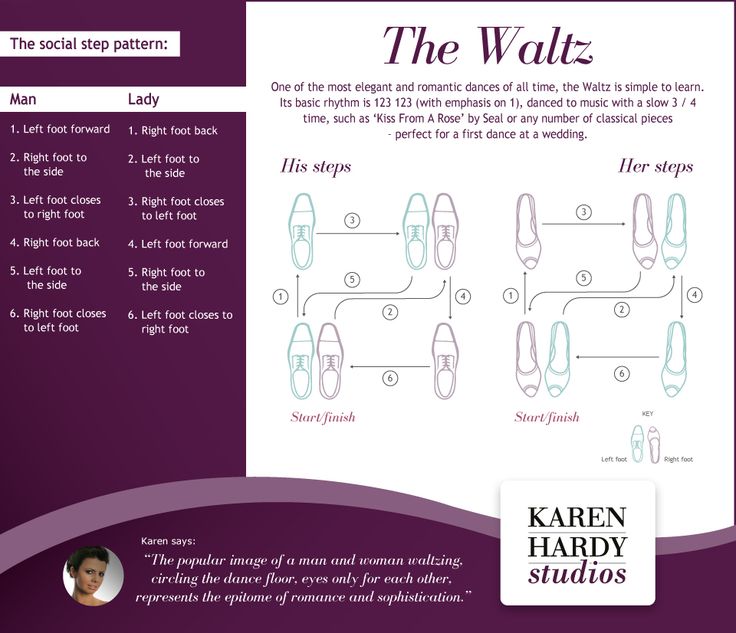 3.2, p. 28 year
3.2, p. 28 year - ↑ (in) Rules and Regulations NDCA, NDCA (in), ( read online [PDF] ) , Section IX.B.4.a.1, p. 36
- ↑ (in) " Tempo Recommendations for Dance Music " on hollywoodballroomdc.com (accessed October 3, 2020)
- ↑ (in) Guy Howard, Ballroom Dancing Technique: Waltz and Basic Principles [“Technique of ballroom dancing: waltz and principles”] ( Rep.









